Experiment and Simulation Study of the Laser-Induced Cavitation Bubble Technique for Forming a Microgroove in Aluminum Foil
Abstract
:1. Introduction
2. Experiment Designs
2.1. Experimental Setups
2.2. Materials and Methods
3. Numerical Simulations
3.1. Simulation Model
3.2. Governing Equations
3.3. Initial Conditions
4. Results and Discussion
4.1. Bubble Dynamic Characteristics
4.2. The Effect of the Initial Position of the Bubble (H)
4.3. The Effect of Laser Energy
4.4. The Effect of the Number of Impacts
4.5. Response Surface Methodology to Optimize the Forming Depth
4.6. The Surface Morphology
5. Thickness Distribution and Hardness Analysis
6. Conclusions
- The energy dispersive spectroscopy analysis of the oxygen content on the bottom of the microgroove revealed that oxidation reactions occurred after the Al foil was processed, and the oxygen content increased from 0.761% to 9.027%.
- The depth of the aluminum foil surface microgroove development increased from 42.3 μm to 103.6 μm, and the laser energy (number of impact) increased from 19 mJ to 31 mJ (1 to 5 times). The microgrooves on the surface of aluminum foil have different depths, with the forming depth in the middle being greater than at both ends.
- The results of the response surface experiments showed that to fabricate microgrooves using the laser-induced cavitation bubble technique, the optimal process conditions were as follows: laser energy is 27 mJ, the number of impacts is 3, and the bubble position is 3 mm.
- By employing an optimal parameter, the flat and smooth microgroove with a forming depth of 102.54 µm was successfully fabricated.
- The maximum thickness thinning of the microgroove section occurred at the entrance area, and this area had the greatest hardness. This also indicated that the greatest amount of plastic deformation of the material occurred in this area.
Author Contributions
Funding
Data Availability Statement
Acknowledgments
Conflicts of Interest
References
- Engel, U.; Eckstein, R. Micro forming—From basic research to its realization. J. Mater. Process. Technol. 2002, 125–126, 35–44. [Google Scholar] [CrossRef]
- Fu, M.; Chan, W.L. A review on the state-of-the-art micro forming technologies. Int. J. Adv. Manuf. Technol. 2013, 67, 2411–2437. [Google Scholar] [CrossRef]
- Zeng, Z.; Li, D.; Yu, Z.; Yang, X.; Li, J.; Kang, R. Study of machining accuracy of micro punching mold using micro-EDM. Procedia CIRP 2018, 68, 588–593. [Google Scholar] [CrossRef]
- Ramezani, M.; Ripin, Z.M.; Ahmad, R. Sheet metal forming with the aid of flexible punch, numerical approach and experimental validation. CIRP J. Manuf. Sci. Technol. 2010, 3, 196–203. [Google Scholar] [CrossRef]
- Zhou, M.; Zhang, Y.K.; Cai, L. Ultrahigh-strain-rate plastic deformation of a stainless-steel sheet with TiN coatings driven by laser shock waves. Appl. Phys. A 2003, 77, 549–554. [Google Scholar] [CrossRef]
- Liu, H.; Shen, Z.; Wang, X.; Wang, H.; Tao, M. Micro mould based laser shock embossing of thin metal sheets for MEMS applications. Appl. Surf. Sci. 2010, 256, 4687–4691. [Google Scholar] [CrossRef]
- Ye, Y.; Feng, Y.; Hua, X.J.; Lian, Z.C. Experimental research on laser shock forming metal foils with femtosecond laser. Appl. Surf. Sci. 2013, 285, 600–606. [Google Scholar] [CrossRef]
- Vollertsen, F.; Hu, Z.; Niehoff, H.S.; Theiler, C. State of the art in micro forming and investigations into micro deep drawing. J. Mater. Process. Technol. 2004, 151, 70–79. [Google Scholar] [CrossRef]
- Liu, H.; Shen, Z.; Wang, X.; Wang, H.; Tao, M. Numerical simulation and experimentation of a novel micro scale laser high speed punching. Int. J. Mach. Tools Manuf. 2010, 50, 491–494. [Google Scholar] [CrossRef]
- Zhang, X.; Zhang, Y.; Zhang, Y.; Pei, S.; Huang, Z. Numerical and experimental investigations of laser shock forming aluminum alloy sheet with mold. Int. J. Mater. Form. 2016, 11, 101–112. [Google Scholar] [CrossRef]
- Gao, H.; Ye, C.; Cheng, G. Deformation behaviors and critical parameters in microscale laser dynamic forming. J. Manuf. Sci. Eng. 2009, 131, 051011–051022. [Google Scholar] [CrossRef]
- Wang, X.; Sun, K.; Ma, Y.; Shen, Z.; Liu, F.; Liu, H. Experimental investigation on laser shock micro hydraulic bulging of copper foil. Opt. Laser Technol. 2019, 115, 390–397. [Google Scholar] [CrossRef]
- Wang, X.; Zhang, D.; Gu, C.; Shen, Z.; Ma, Y.; Gu, Y.; Liu, T.; Liu, H. Micro scale laser shock forming of pure copper and titanium sheet with forming/blanking compound die. Opt. Lasers Eng. 2015, 67, 83–93. [Google Scholar] [CrossRef]
- Liu, H.; Zhang, W.; Gau, J.-T.; Shen, Z.; Ma, Y.; Zhang, G.; Wang, X. Feature size effect on formability of multilayer metal composite sheets under microscale laser flexible forming. Metals 2017, 7, 275. [Google Scholar] [CrossRef]
- Zhong, X.; Eshraghi, J.; Vlachos, P.; Dabiri, S.; Ardekani, A.M. A model for a laser-induced cavitation bubble. Int. J. Multiph. Flow 2020, 132, 103433. [Google Scholar] [CrossRef]
- Ren, X.D.; Wang, J.; Yuan, S.Q.; Adu-Gyamfi, S.; Tong, Y.Q.; Zuo, C.Y.; Zhang, H.F. Mechanical effect of laser-induced cavitation bubble of 2A02 alloy. Opt. Laser Technol. 2018, 105, 180–184. [Google Scholar] [CrossRef]
- Ren, X.D.; He, H.; Tong, Y.Q.; Ren, Y.P.; Yuan, S.Q.; Liu, R.; Zuo, C.Y.; Wu, K.; Sui, S.; Wang, D.S. Experimental investigation on dynamic characteristics and strengthening mechanism of laser-induced cavitation bubbles. Ultrason. Sonochem. 2016, 32, 218–223. [Google Scholar] [CrossRef]
- Takada, N.; Nakano, T.; Sasaki, K. Formation of cavitation-induced pits on target surface in liquid-phase laser ablation. Appl. Phys. A 2010, 101, 255–258. [Google Scholar] [CrossRef]
- Nie, Z.; Ye, Y.; Ren, Y.; Ren, X.; Hua, Y.; Fu, Y. Experimental research on plastic deformation of metal foil through ns laser-induced mechanical effects underwater. Opt. Laser Technol. 2021, 134, 106629. [Google Scholar] [CrossRef]
- Dular, M.; Požar, T.; Zevnik, J.; Petkovšek, R. High speed observation of damage created by a collapse of a single cavitation bubble. Wear 2019, 418–419, 13–23. [Google Scholar] [CrossRef]
- Chen, T.; Guo, Z.; Zeng, B.; Yin, S.; Deng, Y.; Li, H. Experimental research and numerical simulation of the punch forming of aluminum foil based on a laser-induced cavitation bubble. Int. J. Adv. Manuf. Technol. 2017, 93, 3275–3284. [Google Scholar] [CrossRef]
- Wang, L.; Deng, Y.; Zou, Z.; Xiao, Y.; Su, G.; Guo, Z. Microgroove formation in thin copper by laser-induced cavitation bubble shock: Numerical and experimental investigation. Appl. Opt. 2022, 61, 1841–1850. [Google Scholar] [CrossRef] [PubMed]
- Nie, N.; Su, L.; Deng, G.; Li, H.; Yu, H.; Tieu, A.K. A review on plastic deformation induced surface/interface roughening of sheet metallic materials. J. Mater. Res. Technol. 2021, 15, 6574–6607. [Google Scholar] [CrossRef]
- Tarhouni, I.; Frómeta, D.; Casellas, D.; Costa, J.; Maimí, P. Assessing the effect of the experimental parameters in the evaluation of the essential work of fracture in high-strength thin sheets. Eng. Fract. Mech. 2022, 270, 108560. [Google Scholar] [CrossRef]
- Vinogradov, A.; Estrin, Y. Analytical and numerical approaches to modelling severe plastic deformation. Prog. Mater. Sci. 2018, 95, 172–242. [Google Scholar] [CrossRef]
- Salih, O.S.; Ou, H.; Sun, W. Heat generation, plastic deformation and residual stresses in friction stir welding of aluminium alloy. Int. J. Mech. Sci. 2023, 238, 107827. [Google Scholar] [CrossRef]
- Lu, Z.; Gu, J.; Zhang, P.; Luo, C.; Ren, X. Investigation on laser cavitation micro-forming process: Deformation behavior of 1060 aluminum foil and bubble evolution in a gap. J. Manuf. Process. 2021, 67, 619–627. [Google Scholar] [CrossRef]
- Long, J.; Eliceiri, M.; Ouyang, Y.; Zhang, Y.; Xie, X.; Grigoropoulos, C. Effects of immersion depth on the dynamics of cavitation bubbles generated during ns laser ablation of submerged targets. Opt. Lasers Eng. 2020, 137, 106344. [Google Scholar] [CrossRef]
- Wang, L.; Deng, Y.; Zou, Z.; Xiao, Y.; Su, G.; Guo, Z. The forming of microgroove in copper foil on multiple laser-induced cavitation impacts. J. Manuf. Process. 2022, 78, 82–91. [Google Scholar] [CrossRef]
- Gu, J.; Liu, A.; Liu, H.; Ren, X. Study on pulsation characteristics of laser-induced cavitation bubble and its degradation of acid black solution. Opt. Laser Technol. 2023, 162, 109282. [Google Scholar] [CrossRef]
- Roslyakov, I.V.; Shirin, N.A.; Evdokimov, P.V.; Berekchiian, M.V.; Simonenko, N.P.; Lyskov, N.V.; Napolskii, K.S. High-temperature annealing of porous anodic aluminum oxide prepared in selenic acid electrolyte. Surf. Coat. Technol. 2022, 433, 128080. [Google Scholar] [CrossRef]
- Zhang, H.; Ren, X.D.; Tong, Y.Q.; Enoch, A. Surface integrity of 2A70 aluminum alloy processed by laser-induced peening and cavitation bubbles. Results Phys. 2019, 12, 1204–1211. [Google Scholar] [CrossRef]
- Yuan, Z.; Tu, Y.; Yuan, T.; Zhang, Y.; Huang, Y. Size effects on mechanical properties of pure industrial aluminum sheet for micro/meso scale plastic deformation: Experiment and modeling. J. Alloys Compd. 2021, 859, 157752. [Google Scholar] [CrossRef]
- Zhang, H.; He, Z.; Gao, W. Effect of surface severe plastic deformation on microstructure and hardness of Al alloy sheet with enhanced precipitation. Mater. Lett. 2023, 333, 133632. [Google Scholar] [CrossRef]
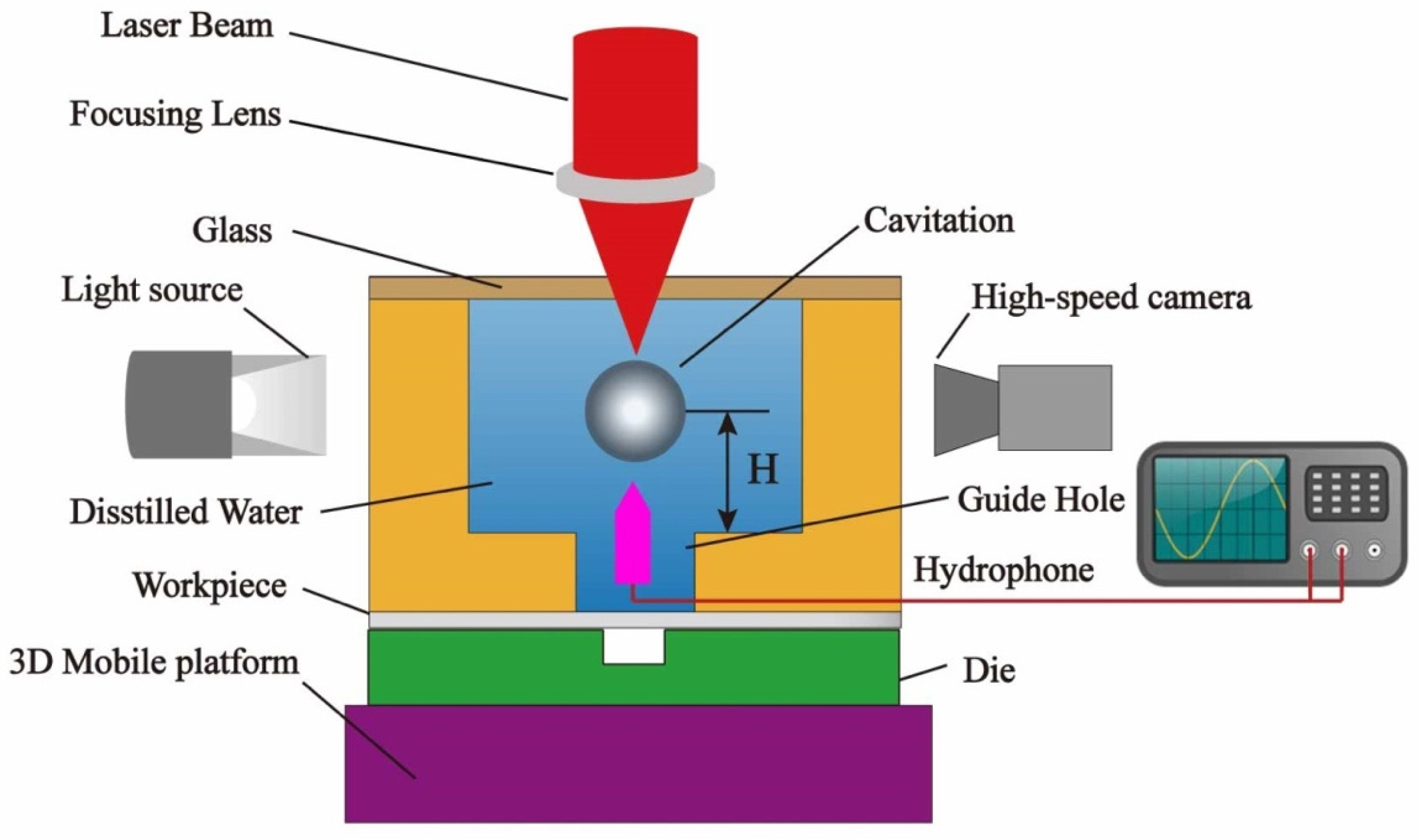
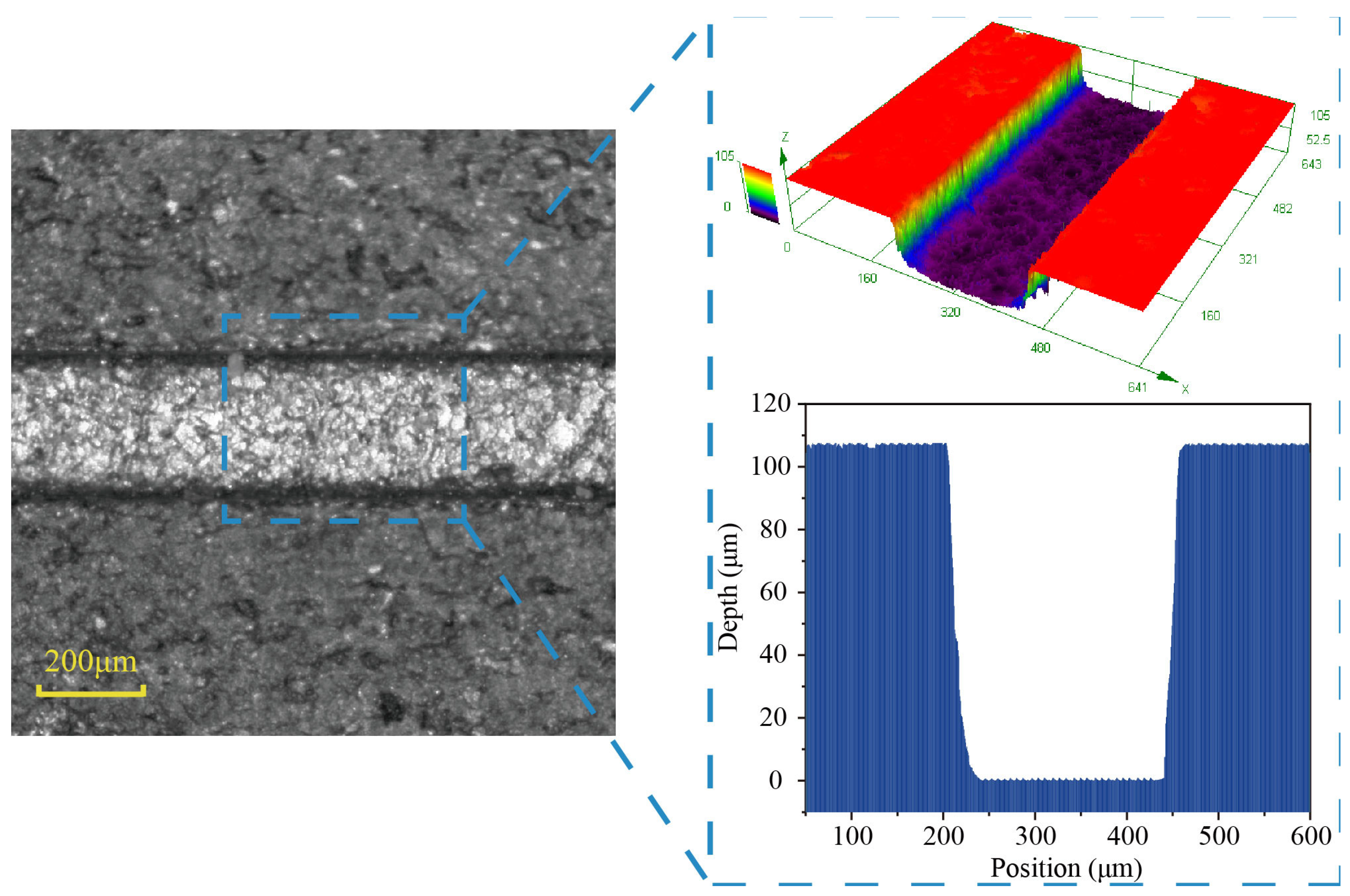
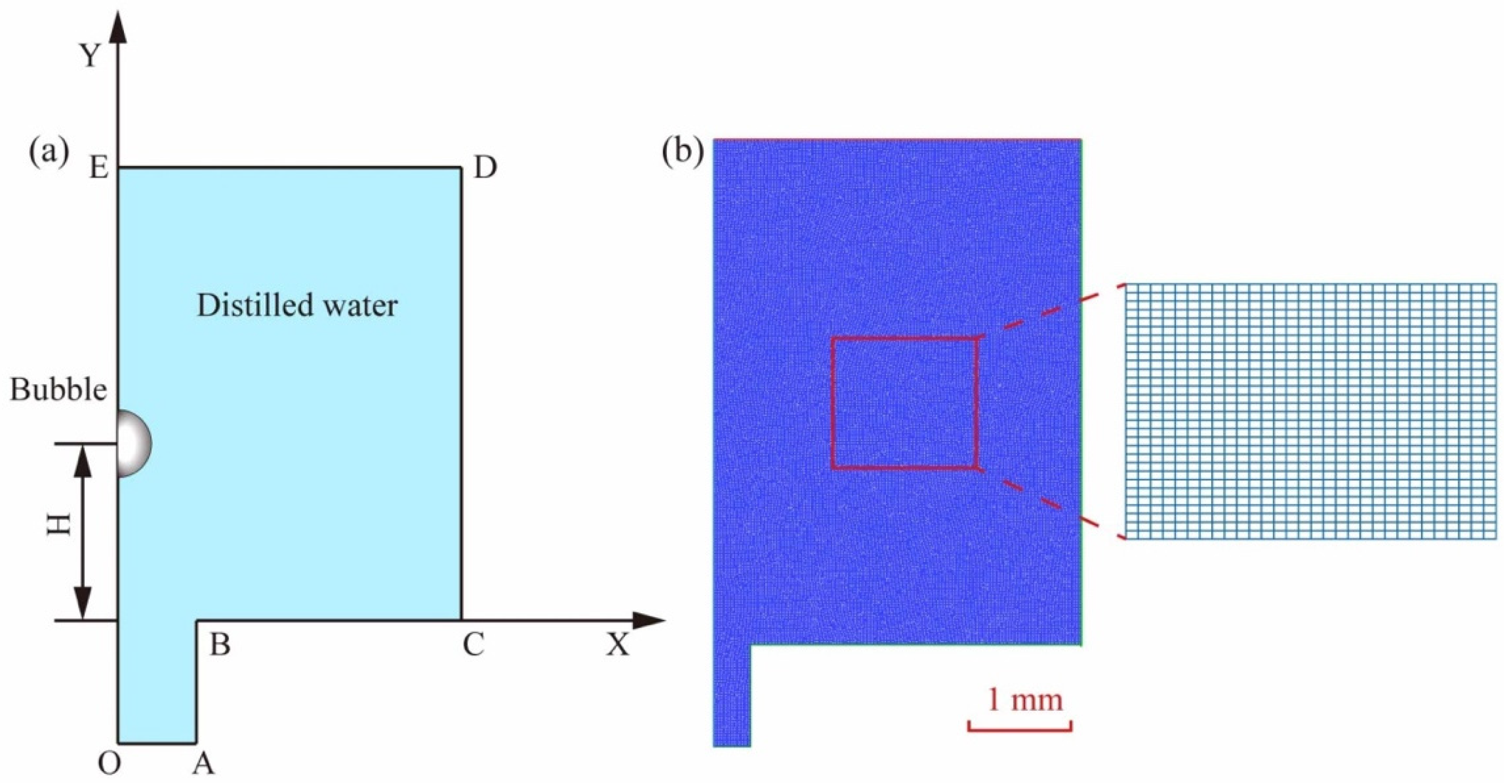

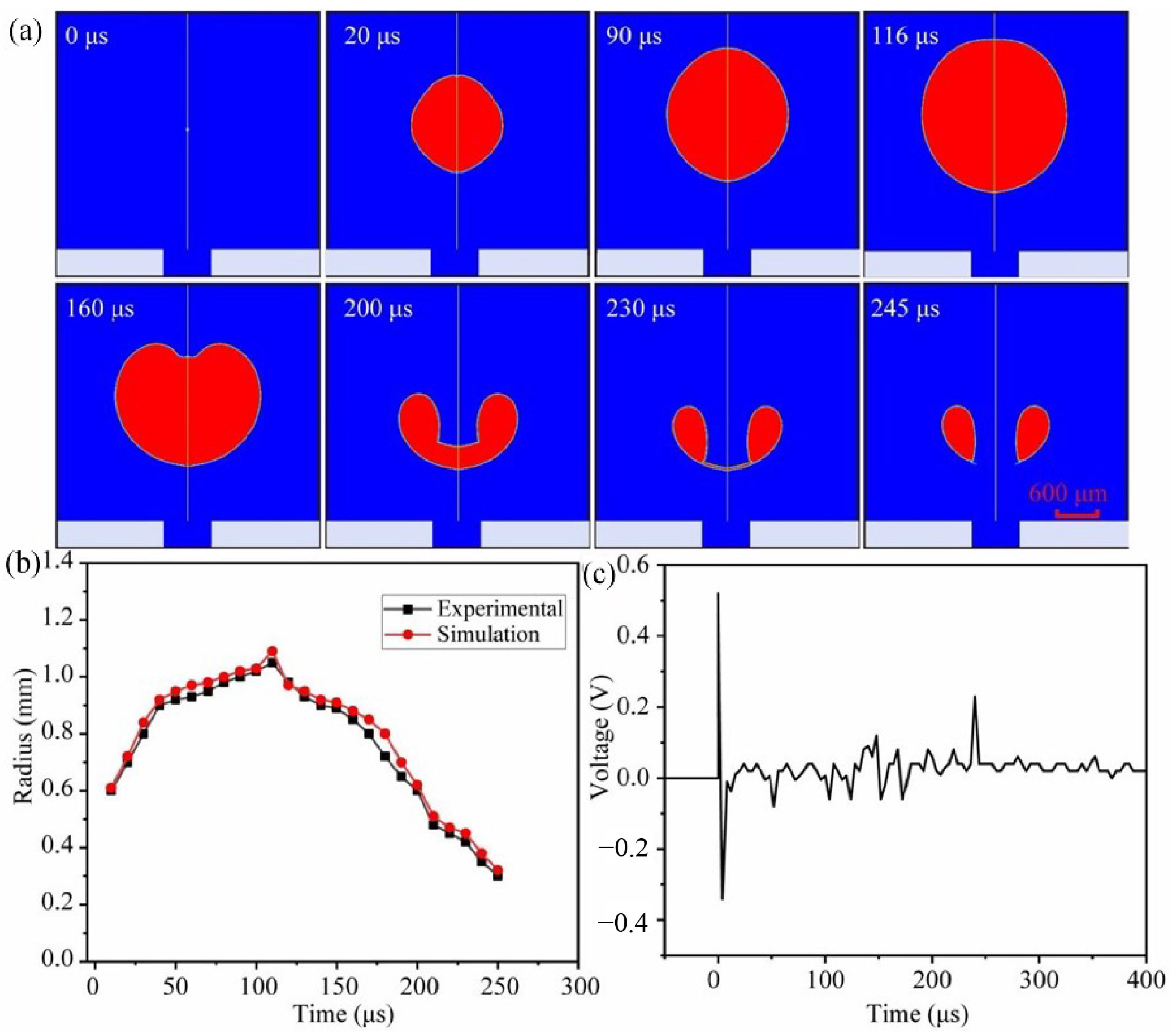
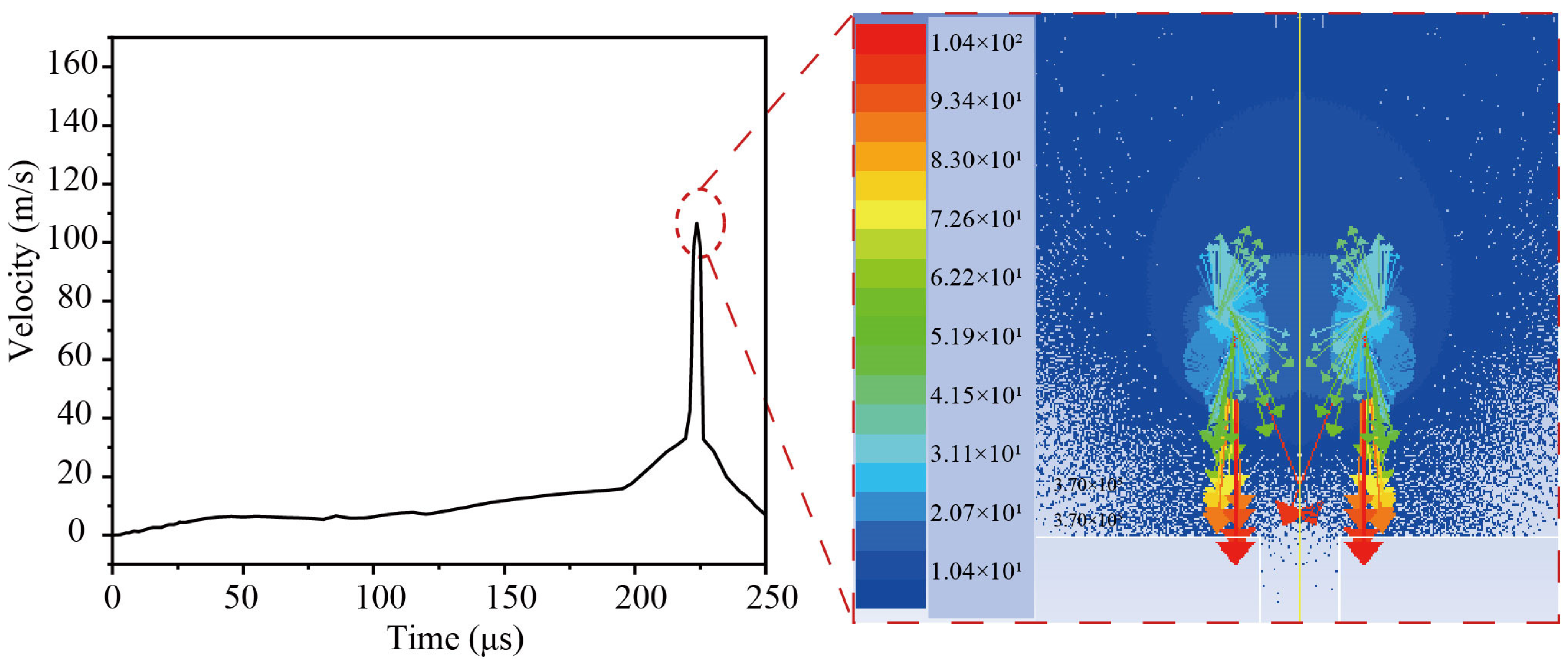

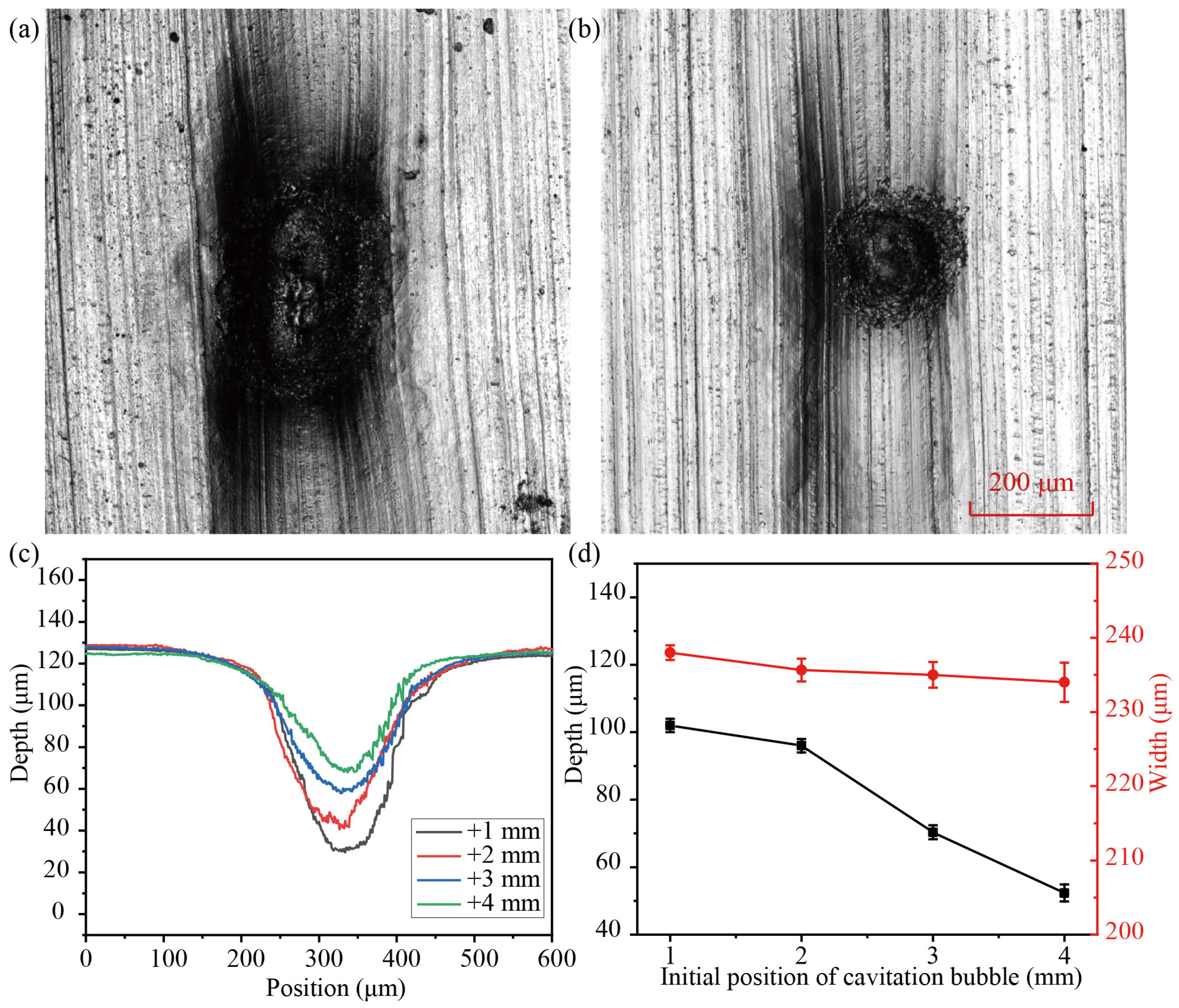


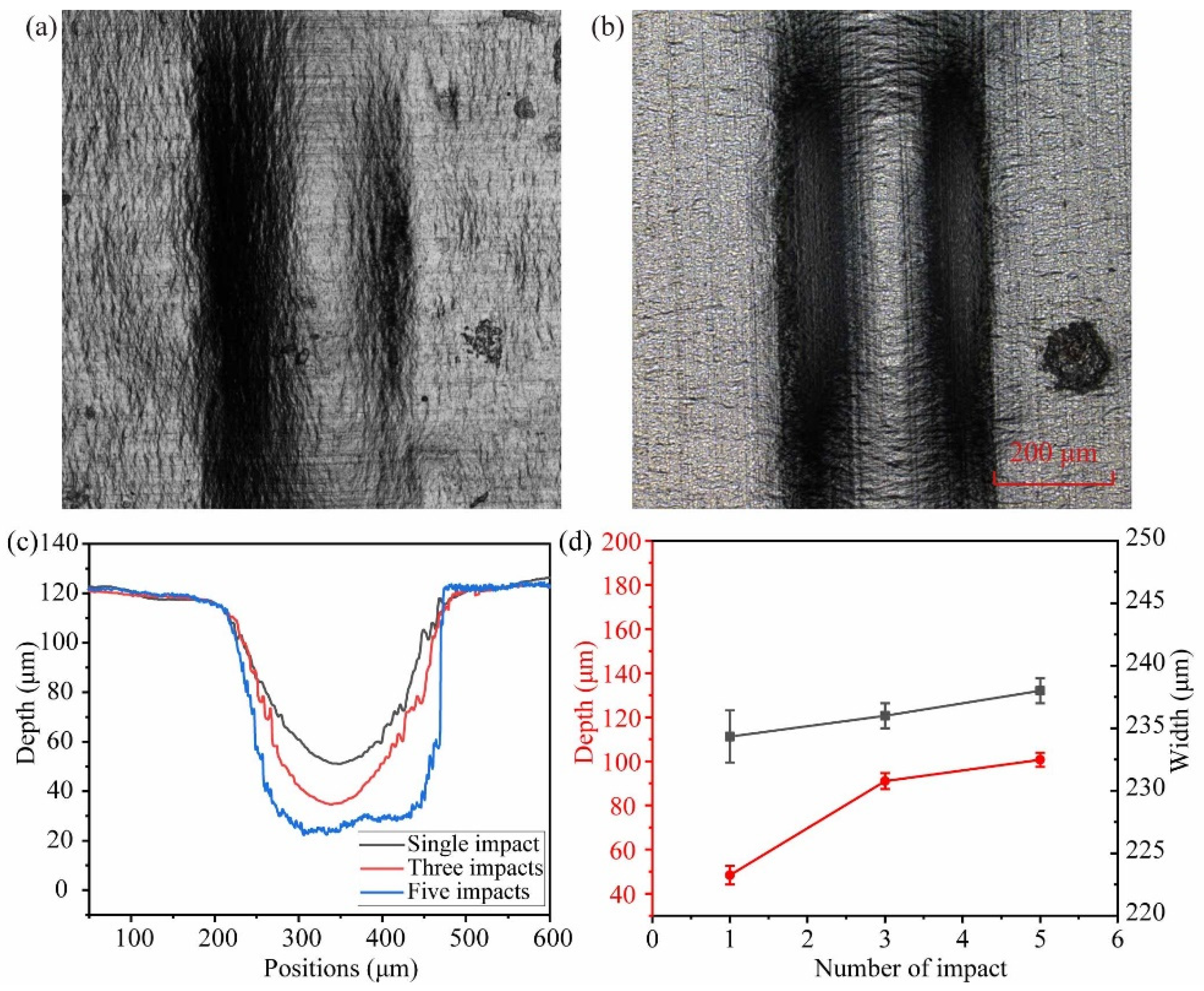

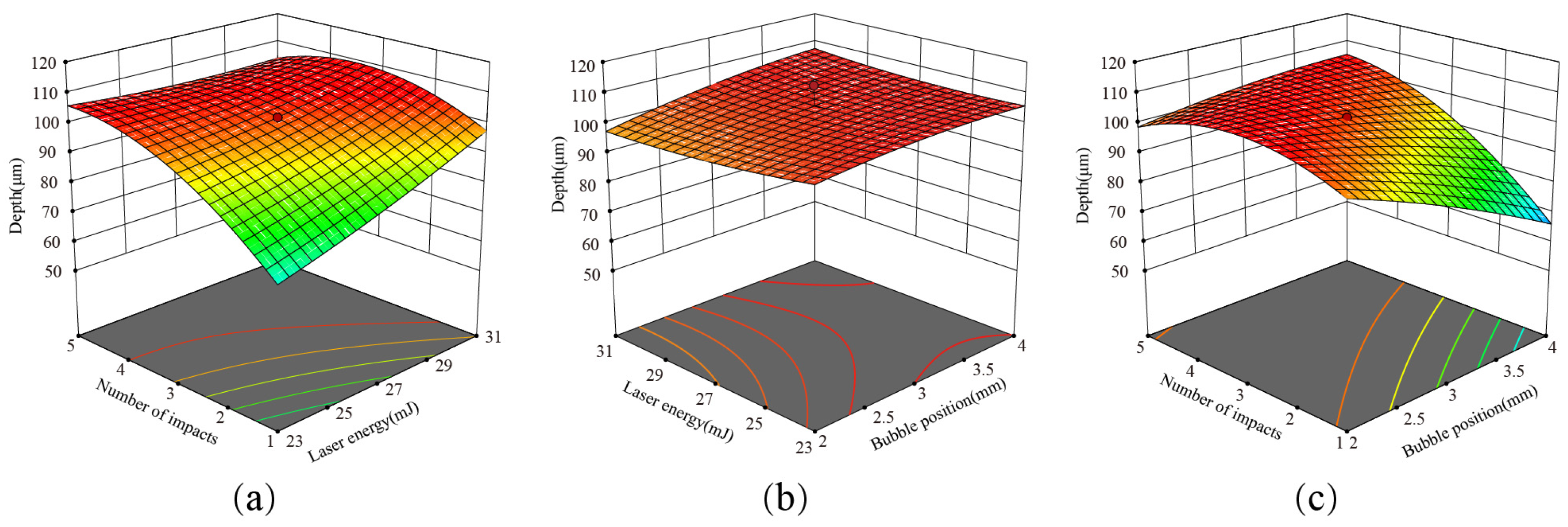

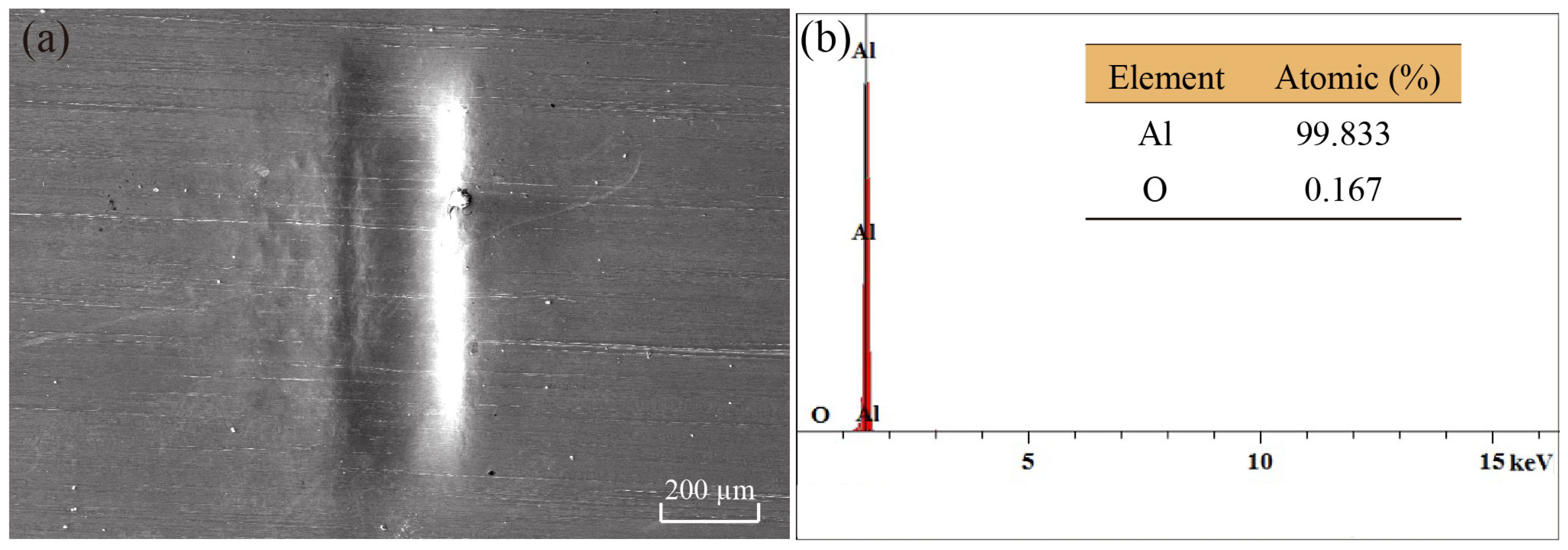
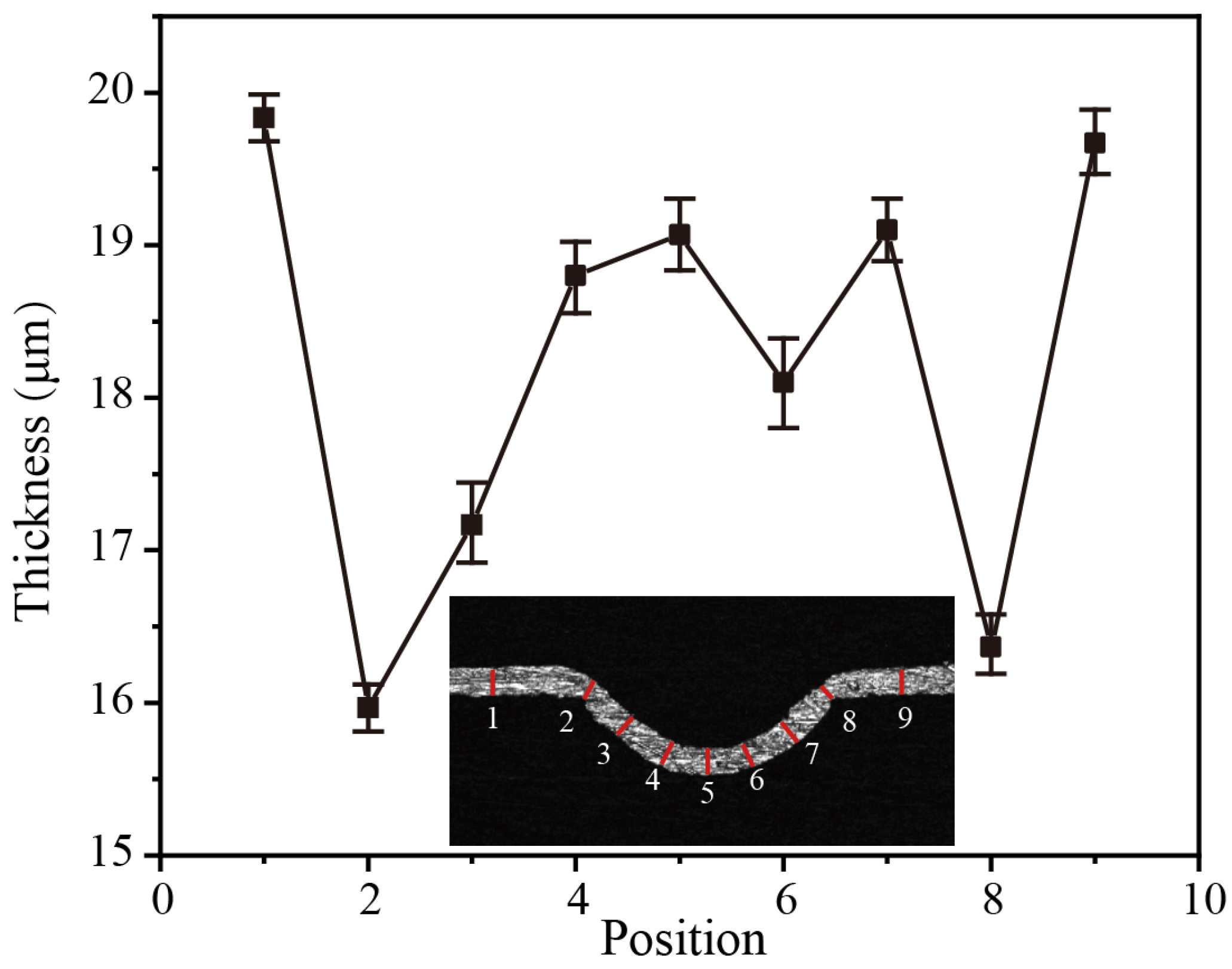


| Level | ||||
|---|---|---|---|---|
| Factor | Mark | −1 | 0 | 1 |
| H (mm) | X1 | 2 | 3 | 4 |
| Energy (mJ) | X2 | 23 | 27 | 31 |
| Number of impacts | X3 | 1 | 3 | 5 |
| Position of Bubble (mm) | Energy (mJ) | Number of Impacts | Depth (μm) | |
|---|---|---|---|---|
| 1 | 2 | 27 | 1 | 100 |
| 2 | 4 | 27 | 1 | 60 |
| 3 | 3 | 27 | 3 | 102 |
| 4 | 4 | 31 | 3 | 103 |
| 5 | 3 | 27 | 3 | 102 |
| 6 | 4 | 23 | 3 | 95 |
| 7 | 3 | 27 | 3 | 102 |
| 8 | 3 | 31 | 5 | 105 |
| 9 | 2 | 23 | 3 | 104 |
| 10 | 3 | 27 | 3 | 102 |
| 11 | 2 | 27 | 5 | 105 |
| 12 | 3 | 23 | 1 | 72 |
| 13 | 4 | 27 | 5 | 104 |
| 14 | 3 | 31 | 1 | 103.5 |
| 15 | 2 | 31 | 3 | 105 |
| 16 | 3 | 27 | 3 | 102 |
| 17 | 3 | 23 | 5 | 100 |
| Source | Sum of Squares | df | Mean Square | F Value | p-Value | |
|---|---|---|---|---|---|---|
| Model | 2236.67 | 9 | 248.52 | 6.83 | 0.0095 | significant |
| X1 | 338.00 | 1 | 338.00 | 9.29 | 0.0186 | |
| X2 | 258.78 | 1 | 258.78 | 7.12 | 0.0321 | |
| X3 | 770.28 | 1 | 770.28 | 21.18 | 0.0025 | |
| X1X2 | 12.25 | 1 | 12.25 | 0.3369 | 0.57 | |
| X1X3 | 380.25 | 1 | 380.2 | 10.46 | 0.0144 | |
| X2X3 | 175.56 | 1 | 175.5 | 4.83 | 0.0640 | |
| X12 | 10.28 | 1 | 10.28 | 0.2827 | 0.6114 | |
| X22 | 7.25 | 1 | 7.25 | 0.1995 | 0.6687 | |
| X32 | 282.25 | 1 | 282.25 | 7.76 | 0.0271 | |
| Residual | 254.56 | 7 | 36.37 | |||
| Lack of Fit | 254.56 | 3 | 84.85 | |||
| Cor Total | 2491.24 | 16 |
Disclaimer/Publisher’s Note: The statements, opinions and data contained in all publications are solely those of the individual author(s) and contributor(s) and not of MDPI and/or the editor(s). MDPI and/or the editor(s) disclaim responsibility for any injury to people or property resulting from any ideas, methods, instructions or products referred to in the content. |
© 2023 by the authors. Licensee MDPI, Basel, Switzerland. This article is an open access article distributed under the terms and conditions of the Creative Commons Attribution (CC BY) license (https://creativecommons.org/licenses/by/4.0/).
Share and Cite
Wang, L.; Su, C.; Jia, X.; Guo, Z.; Zou, Z. Experiment and Simulation Study of the Laser-Induced Cavitation Bubble Technique for Forming a Microgroove in Aluminum Foil. Micromachines 2023, 14, 2106. https://doi.org/10.3390/mi14112106
Wang L, Su C, Jia X, Guo Z, Zou Z. Experiment and Simulation Study of the Laser-Induced Cavitation Bubble Technique for Forming a Microgroove in Aluminum Foil. Micromachines. 2023; 14(11):2106. https://doi.org/10.3390/mi14112106
Chicago/Turabian StyleWang, Liangliang, Chun Su, Xiaofeng Jia, Zhongning Guo, and Zhixiang Zou. 2023. "Experiment and Simulation Study of the Laser-Induced Cavitation Bubble Technique for Forming a Microgroove in Aluminum Foil" Micromachines 14, no. 11: 2106. https://doi.org/10.3390/mi14112106
APA StyleWang, L., Su, C., Jia, X., Guo, Z., & Zou, Z. (2023). Experiment and Simulation Study of the Laser-Induced Cavitation Bubble Technique for Forming a Microgroove in Aluminum Foil. Micromachines, 14(11), 2106. https://doi.org/10.3390/mi14112106








